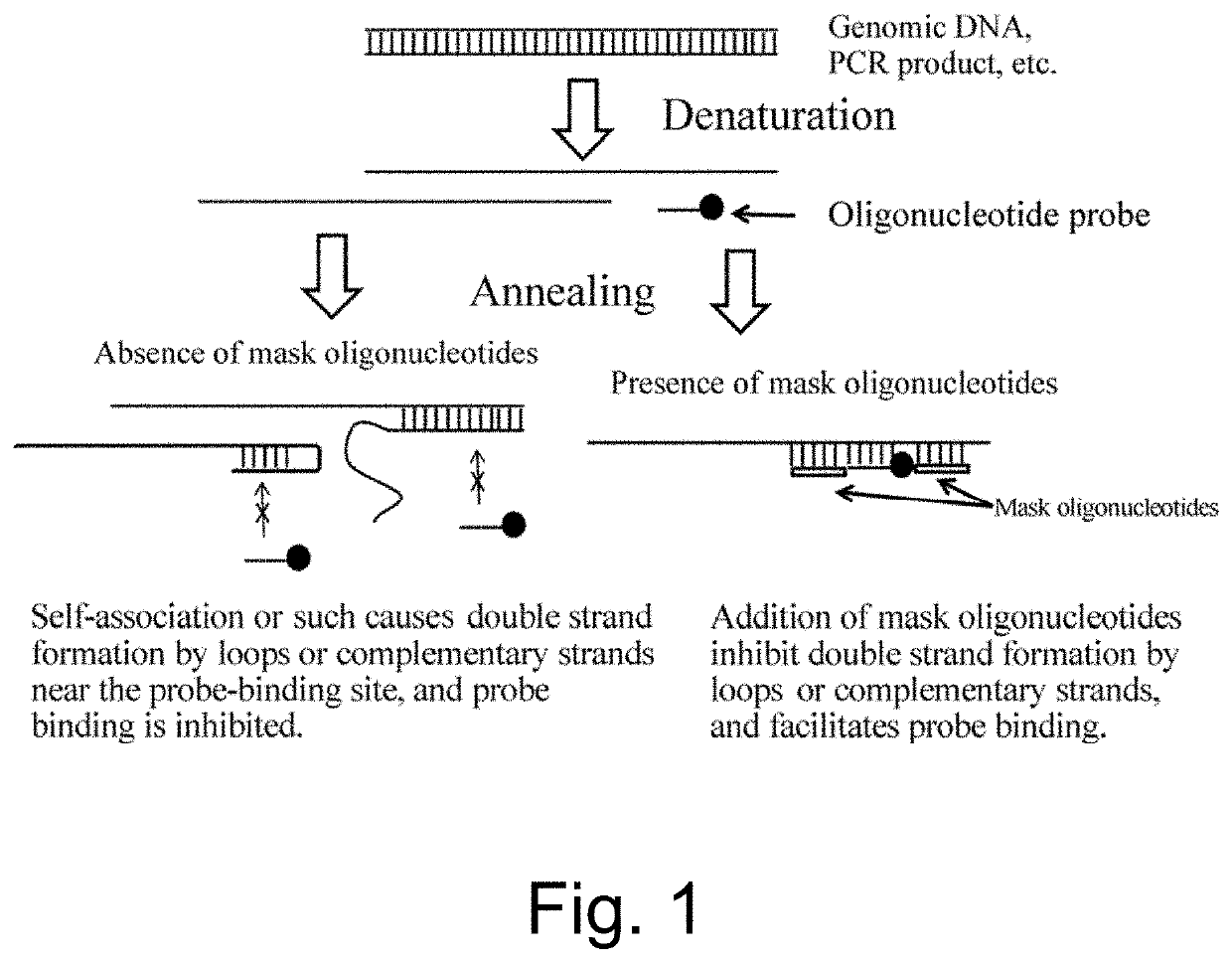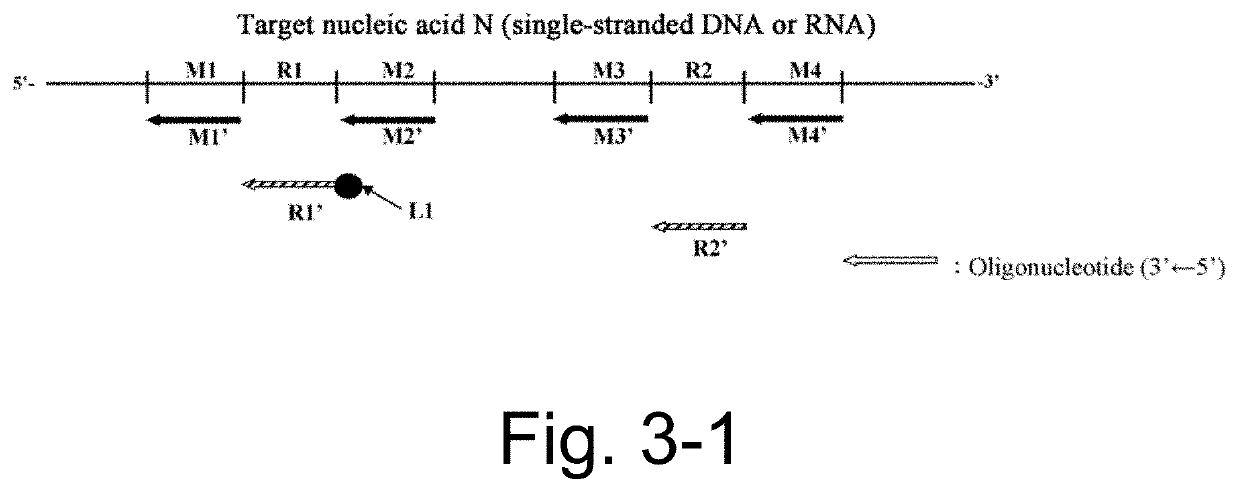Nucleic acid detection or quantification method using mask oligonucleotide, and device for same
a nucleic acid and mask technology, applied in the direction of microorganism testing/measurement, biochemistry apparatus and processes, etc., can solve the problems of inability to accurately detect the target nucleic acid, the time required for nucleic acid amplification is relatively short, and the operation of pcr apparatuses is not particularly complicated, etc., to achieve mild denaturation conditions and high rate
- Summary
- Abstract
- Description
- Claims
- Application Information
AI Technical Summary
Benefits of technology
Problems solved by technology
Method used
Image
Examples
example 1
Detection of PCR Products of Genomic DNAs of Various Bacteria by Nucleic Acid Chromatoraphy Using Mask Oligonucleotides
1. Preparation of Template DNAs for PCR
[0536]Template DNAs for PCR were prepared as genomic DNAs using ISOPLANT (NIPPON GENE).
[0537]More specifically, each of Staphylococcus aureus (abbreviated as “SA”, bacterial strain ATCC 12600), Staphylococcus epidermidis (abbreviated as “SE”, bacterial strain ATCC 14990), Pseudomonas aeruginosa (abbreviated as “PA”, bacterial strain JCM5962), Enterococcus faecalis (abbreviated as “EF”, bacterial strain JCM5803), Escherichia coli (abbreviated as “EC”, bacterial strain JCM1649), Enterobacter cloacae (abbreviated as “ET”, bacterial strain JCM1232), and Klebsiella pneumoniae (abbreviated as “KP”, bacterial strain JCM 1662) was cultured overnight in 3 mL of LB liquid medium (Becton Dickinson). 1 mL of the obtained test bacterial solution was centrifuged at 6,000×g for five minutes, and then the residue was suspended in 300 μL of Ext...
example 2
Detection of Restriction Enzyme-Treated Fragments of Bacterial Genomic DNAs by Nucleic Acid Chromatography Using Mask Oligonucleotides
1. Preparation of Bacterial Genomic DNAs
[0583]Escherichia coli (abbreviated as “EC” below; bacterial strain JCM1649) and Enterobacter cloacae (abbreviated as “ET” below; bacterial strain JCM1232) were cultured overnight in 5 mL of BHI liquid medium (Becton Dickinson). The test bacterial solution was centrifuged at 1,870×g (Allegra 6KR Centrifuge, Becton Dickinson) for ten minutes, and the supernatant was discarded. The remainder was washed with TE buffer [10 mM Tris-HCl (pH 8.0), 1 mM Ethylenediamine tetraacetic acid (EDTA)], and centrifuged again at 1,870×g for ten minutes, and the supematant was discarded. The remainder was suspended in 900 L of TE buffer. Next, 300 μL of 5 mg / mL lysozyme (SEIKAGAKU CORPORATION) was added to the suspension solution, and the treatment was carried out at 37° C. for 30 minutes. Subsequently, 150 μL of 10 mg / mL Protease...
example 3
Specific Detection of Target Nucleic Acids in PCR Products Obtained by Multiplex PCR on Bacterial Genomic DNAs Using Nucleic Acid Chromatography with Mask Oligonucleotides
1. Preparation of Template Genomic DNAs for Multiplex PCR
[0604]Campylobacter jejuni (bacterial strain ATCC700819), Campylobacter jejuni (bacterial strain 81-176), Campylobacter coli (bacterial strain ATCC33559), Campylobacter coli (bacterial strain ATCC43478), Campylobacter fetus (bacterial strain ATCC27374), Campylobacter fetus (bacterial strain ATCC 19438), Campylobacter hyointestinalis (bacterial strain ATCC35217), Campylobacter lari (bacterial strain ATCC43675) and Campylobacter upsaliensis (bacterial strain ATCC43956) were cultured on a blood agar medium at 37° C. for 3 days under microaerophilic conditions. Colonies obtained from each of the bacterial strains were suspended in TE, and template genomic DNAs were prepared by a boiling method. More specifically, the suspension solutions were boiled for ten minut...
PUM
| Property | Measurement | Unit |
|---|---|---|
| time | aaaaa | aaaaa |
| temperature | aaaaa | aaaaa |
| concentration | aaaaa | aaaaa |
Abstract
Description
Claims
Application Information
 Login to View More
Login to View More - R&D
- Intellectual Property
- Life Sciences
- Materials
- Tech Scout
- Unparalleled Data Quality
- Higher Quality Content
- 60% Fewer Hallucinations
Browse by: Latest US Patents, China's latest patents, Technical Efficacy Thesaurus, Application Domain, Technology Topic, Popular Technical Reports.
© 2025 PatSnap. All rights reserved.Legal|Privacy policy|Modern Slavery Act Transparency Statement|Sitemap|About US| Contact US: help@patsnap.com



